Dogs
How to Take a Dogs Temperature Safely in 10 Steps

To check a dog's temperature safely, select the right thermometer such as an ear or rectal one for accuracy. Gather supplies like a digital thermometer and lubricant. Make sure your dog is comfortable in a quiet space. Insert the rectal thermometer carefully with lubrication. Hold it steady for 1-2 minutes. Securely fasten the thermometer in place to prevent slipping. Record the temperature promptly and consult a vet if needed. Remember a normal range is 100-102.5°F. Seek professional advice for temperatures above 104°F. Following these steps guarantees a safe process and accurate assessment of your dog's health.
Key Takeaways
- Use a lubricated, veterinary-labeled rectal thermometer.
- Securely hold thermometer steady for 1-2 minutes.
- Record temperature promptly and consult a vet.
- Monitor dog's reaction for discomfort during insertion.
- Maintain a log of temperature readings for trends.
Choosing the Right Thermometer
When selecting a thermometer for your dog, opt for either an ear or rectal thermometer to guarantee accurate and safe temperature readings.
Ear thermometers are convenient and quick to use, making them ideal for dogs who may not tolerate having a thermometer inserted rectally. They provide a reliable temperature reading in just a few seconds.
On the other hand, rectal thermometers are considered the most accurate way to measure a dog's temperature. While it may require a bit more time and patience, inserting the rectal thermometer properly ensures a precise reading, critical for monitoring your dog's health.
Both options are safe when used correctly, but it's vital to choose the method that best suits your dog's temperament and comfort level.
Prepare Necessary Supplies

To guarantee a successful temperature reading for your dog, gather essential supplies such as a digital thermometer, water-based lubricant, and pet restraint tools. A digital thermometer is preferred for its accuracy and ease of use. Make sure the thermometer is labeled exclusively for veterinary use to avoid any chance of cross-contamination.
The water-based lubricant will make the process more comfortable for your dog and help with the insertion of the thermometer for a rectal temperature reading. Additionally, having pet restraint tools on hand will assist in keeping your dog still during the procedure, ensuring safety for both you and your furry friend.
Prepare a designated area with good lighting to accurately measure the temperature. Having towels or blankets nearby can provide comfort and support for your dog during the process. Keeping treats or rewards handy can also help keep your dog calm and cooperative throughout the temperature-taking process.
Ensure Your Dog Is Comfortable
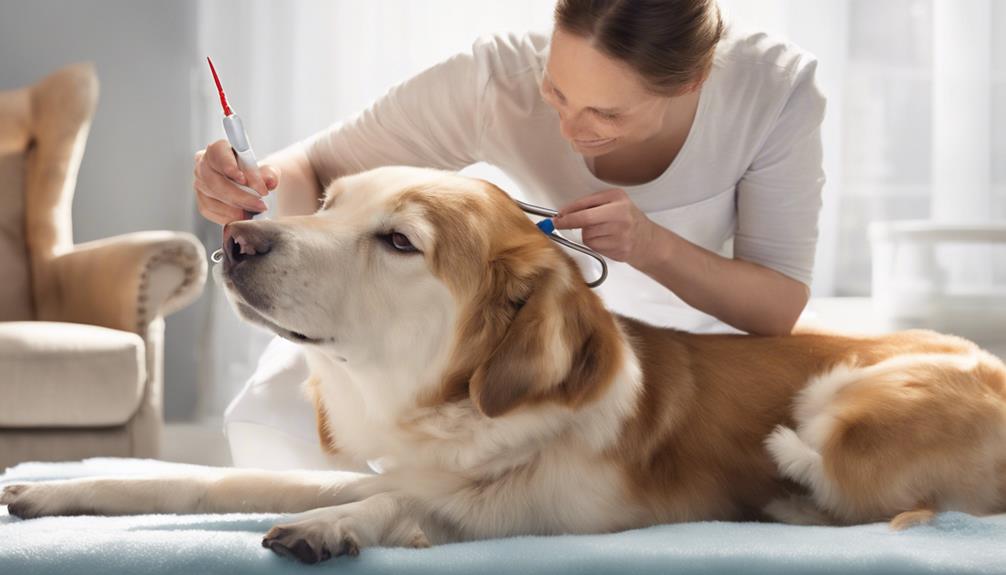
Guaranteeing our furry companions feel at ease is paramount during the temperature-taking process. To start, choose a quiet and comfortable location for the temperature check. This helps reduce stress on your dog, making the experience more pleasant.
Use gentle restraint to keep your dog still, such as softly holding their ear or gently securing them in place. Speaking in soothing tones can reassure your dog and help keep them calm. Offering treats or positive reinforcement creates a positive association with temperature checks.
Take your time and avoid rushing the process to ensure your dog feels comfortable throughout. If needed, use proper restraint to prevent excessive movement during the measurement. Remember, a calm and relaxed dog will make it easier to get an accurate reading of their normal body temperature.
Insert the Rectal Thermometer

When inserting the rectal thermometer, remember to only push it 1-2 inches into the dog's rectum for an accurate reading.
Lubricate the thermometer with petroleum jelly or baby oil to make the process smoother.
Hold the thermometer steady for 1-2 minutes to guarantee a stable temperature reading.
Inserting the Thermometer Properly
How deep should we insert the rectal thermometer to guarantee an accurate temperature reading for our dog?
To make sure an accurate reading, insert the rectal thermometer approximately 1-2 inches into your dog's rectum. It's essential to gently and securely place the thermometer against the rectal wall for the most precise measurement. Holding the thermometer in place for 1-2 minutes allows for an appropriate temperature reading.
To aid in smooth insertion and provide comfort for your dog, consider lubricating the thermometer tip with petroleum jelly or baby oil. Proper insertion depth is key in obtaining an accurate temperature reading, so take care to insert the thermometer correctly to make sure the most reliable results for your pet's health assessment.
Ensuring Comfort and Safety
How can we guarantee the comfort and safety of our dog when inserting the rectal thermometer?
- Prepare the rectal thermometer with a water-based lubricant to facilitate insertion.
- Gently insert the thermometer to the specified depth in the rectum.
- Make sure your dog is lying down for a more comfortable and accurate temperature reading.
- Remember to label the thermometer exclusively for animal use to prevent cross-contamination.
Monitoring Temperature Accurately
For a vital temperature reading, carefully insert the rectal thermometer 1-2 inches into the dog's rectum for 1-2 minutes. This guarantees accurate temperature readings. Remember to lubricate the thermometer tip with petroleum jelly or baby oil for easier insertion.
Rectal thermometers provide the most dependable and precise temperature measurements in dogs. While monitoring the process, pay attention to the dog's reaction for any signs of discomfort. Proper insertion depth and duration are essential for obtaining an accurate reading.
Hold the Thermometer in Place

To guarantee an accurate temperature reading, delicately hold the thermometer in place to prevent it from slipping out during the measurement. When handling this critical step, remember the following:
- Ensure it's securely inserted: Proper insertion guarantees an accurate reading.
- Gently hold the thermometer: Preventing it from slipping out is essential for precise results.
- Avoid sudden movements: Any sudden shifts could disrupt the thermometer's position.
- Keep the thermometer steady: A steady hand ensures consistent contact with the rectal wall.
Record the Temperature Reading

When taking your dog's temperature, it's essential to record the reading promptly. This allows us to monitor any changes and identify abnormalities.
Interpret the Reading
Upon recording the temperature reading immediately after taking it, we noted it as 101 degrees Fahrenheit. When interpreting the reading, it's vital to understand the importance of the temperature for your dog's health. Here are some key points to keep in mind:
- Consult with Your Vet: Share the temperature reading with your veterinarian to seek their professional evaluation.
- Keep a Log: Maintain a record of temperature readings to track any changes over time.
- Monitor Trends: Analyze the data to identify any patterns or abnormalities in your dog's temperature.
- Ensure Health Evaluation: Regularly checking your dog's temperature helps in assessing their overall health status.
Note Any Abnormalities
After recording the temperature reading of 101 degrees Fahrenheit, it's crucial to note any abnormalities such as elevated or low temperatures that may indicate potential health issues in your dog.
Monitoring your dog's temperature regularly can help you detect any abnormalities early on. If you observe consistently high or low temperatures, it's vital to seek veterinary attention promptly.
Keeping a log of temperature readings allows you to track any fluctuations over time. Any significant changes in temperature readings should be documented and shared with your veterinarian for further evaluation.
Monitor Trends Over Time
To track trends over time, we consistently record the temperature reading each time we take our dog's temperature. By documenting temperature variations, we can monitor changes in health and identify any abnormalities early on. Keeping a log of temperature readings allows us to track trends and provide valuable information to our veterinarian during check-ups.
This consistent temperature recording not only helps in evaluating our dog's overall well-being but also aids in detecting underlying health issues promptly. Remember, staying vigilant and documenting temperature trends can play an important role in keeping our furry friends healthy and happy.
Monitor Normal Temperature Range

Monitoring the typical temperature range of a dog is essential for evaluating their health status accurately. A dog's normal temperature falls between 100-102.5°F, with any deviation indicating an underlying issue. Fever in dogs is often a sign of infection, prompting the immune system to respond. Abnormal temperatures, whether too high or too low, can harm the body and should be addressed promptly. By understanding the normal dog temperature range, pet owners can better gauge their dog's well-being and seek appropriate care when needed. To help visualize this range, refer to the table below:
| Temperature Range (°F) | Description |
|---|---|
| Below 100°F | Below Normal |
| 100-102.5°F | Normal Range |
| 102.6-104°F | Mild Fever |
| 104.1-106°F | Moderate Fever |
| Above 106°F | High Fever |
Attend a Pet First Aid Course

When it comes to caring for our furry friends, attending a pet first aid course is vital. By learning essential pet skills, gaining first aid knowledge, and enhancing emergency preparedness, we can be better equipped to handle any unforeseen situations.
These courses cover important topics like CPR, wound care, and temperature monitoring, providing us with the tools needed to respond effectively in times of need.
Learn Essential Pet Skills
Have you considered attending a pet first aid course to learn essential skills for handling emergencies with your furry companion? Attending such a course can equip you with the knowledge needed to confidently handle health emergencies your pet may face.
Here are some benefits of attending a pet first aid course:
- Learn how to gently monitor your pet's temperature.
- Gain knowledge on pet first aid techniques, including CPR and wound care.
- Understand the normal temperature ranges and critical signs for your pet.
- Be prepared to handle various health emergencies effectively.
Gain First Aid Knowledge
Considering attending a pet first aid course to equip yourself with essential skills for handling emergencies with your furry companion can be a proactive step towards ensuring your pet's well-being.
Attending such a course provides valuable knowledge on taking a dog's temperature safely, a critical aspect of first aid. You'll learn how to recognize signs of distress and when to seek veterinary assistance promptly.
Understanding the significance of quick and appropriate action during pet health emergencies is key. Acquiring these skills will enable you to effectively care for your pet in critical situations before professional help arrives.
Enhance Emergency Preparedness
Attending a pet first aid course greatly enhances our preparedness for handling a variety of pet health emergencies effectively. These courses provide essential knowledge on how to respond to emergencies and administer basic first aid to pets. Learning pet first aid can help pet owners act quickly and effectively in critical situations, potentially saving their pet's life.
Pet first aid courses cover topics like CPR, wound care, choking, and recognizing signs of distress or illness in pets.
- Gain crucial skills in administering first aid to pets
- Learn how to respond promptly to pet health emergencies
- Enhance confidence in handling critical situations
- Acquire knowledge to potentially save your pet's life
Seek Veterinary Advice When Needed

Seeking veterinary advice promptly is essential when your dog's temperature deviates above 104°F or below 99°F. Consulting with a vet guarantees accurate interpretation of temperature readings and appropriate treatment for any temperature-related concerns. It is vital for dog parents to reach out to veterinary professionals for guidance on abnormal temperature readings.
Here is a helpful table to understand when to seek veterinary advice regarding your dog's temperature:
| Temperature Range | Action Needed |
|---|---|
| Above 104°F | Contact your vet immediately. |
| Below 99°F | Seek veterinary advice promptly. |
Important Reminders for Temperature Monitoring
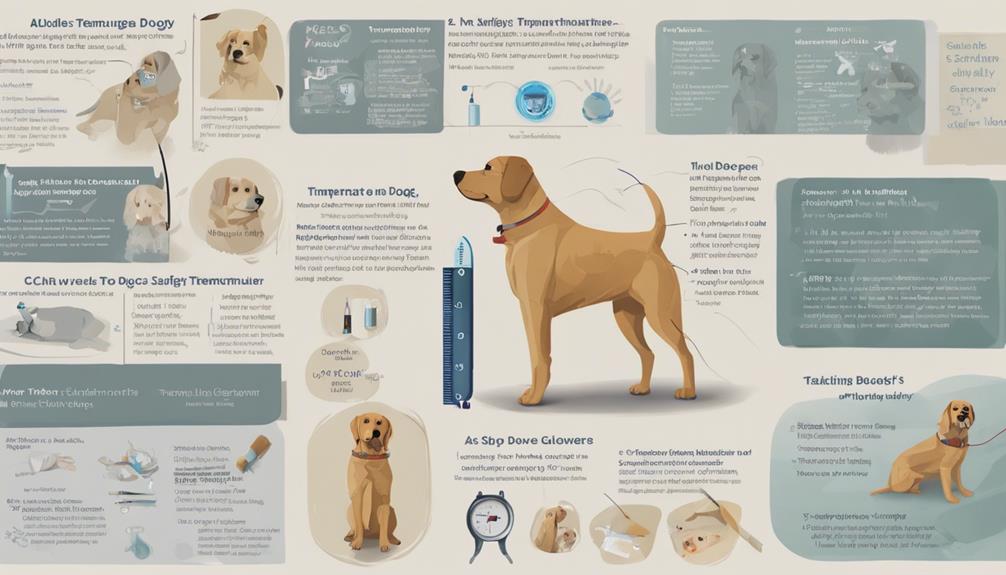
To guarantee precise temperature monitoring for your dog, it's essential to use a correctly labeled thermometer and record temperatures accurately. When monitoring your dog's body temperature, here are some important reminders to keep in mind:
- Normal Range: A dog's normal temperature typically falls between 99.5–102.5 °F (37.5–39.2 °C).
- Digital Thermometer: Make sure you use a digital thermometer specifically designed for rectal temperature readings for accurate results.
- Veterinary Attention: If your dog's temperature rises above 104 °F (40 °C), seek immediate veterinary attention.
- Regular Checks: Monitoring your dog's temperature regularly can help establish a baseline for their health and aid in early illness detection.
Frequently Asked Questions
How Do You Take a Dog's Temperature?
Taking a dog's temperature involves using a digital rectal thermometer, lubricating it, gently inserting it into the rectum, and holding it against the rectal wall for 1-2 minutes.
Normal dog temperature ranges from 99.5–102.5 °F (37.5–39.2 °C). If the temperature exceeds 104 °F (40 °C), seek immediate veterinary attention.
This method guarantees an accurate reading and helps monitor your dog's health effectively.
Can I Take My Dogs Temperature With a Touchless Thermometer?
Touchless thermometers aren't advised for taking a dog's temperature due to their potential inaccuracies. The distinctive shape of dog ear canals and the lack of contact with the body surface may lead to inconsistent readings.
To guarantee precise temperature assessment, it's best to avoid touchless thermometers and opt for rectal thermometers, which provide more reliable results.
Monitoring your dog's health through proper temperature measurement is vital for their well-being.
How Can I Check My Dog's Temperature Without a Thermometer?
Without a thermometer, checking your dog's temperature can be done by observing signs like lethargy or shivering. Feeling their ears, paws, or nose for warmth can also give you an idea.
Pay attention to hydration levels, appetite, and energy too. Look for redness in eyes or gums, coughing, and changes in food intake.
When in doubt, seek prompt vet advice for proper evaluation and treatment.
Can You Take a Dog's Temperature With an Ear Thermometer?
Yes, you can take a dog's temperature with an ear thermometer. It's designed specifically for measuring temperature in the ear canal.
To do so accurately, gently insert the thermometer tip into the dog's ear canal. This method is less invasive and provides a quick reading. Proper positioning of the thermometer is essential for precise measurements.
Ear thermometers are suitable for home use and can be convenient for monitoring your dog's temperature.
Conclusion
In summary, taking your dog's temperature is a vital skill for pet owners to have. Remember, just like with people, a dog's temperature can be an important indicator of their health.
So, make sure to choose the right thermometer, prepare your supplies, and follow the steps carefully to guarantee a safe and accurate reading.
By monitoring your dog's temperature regularly, you can help keep them happy and healthy. Remember, a healthy dog is a happy dog!
Dana is our Lead Content Writer, bringing a wealth of knowledge and expertise to our team. With a background deeply rooted in animal studies and a profound love for all creatures, Dana is dedicated to crafting engaging and informative content that resonates with our audience. With Dana at the helm, you can trust that our content is accurate and engaging, catering to the diverse interests of animal enthusiasts everywhere.
Dogs
Dogs Are Better Than Cats: 7 Reasons

We are firm believers that dogs surpass cats for seven crucial reasons. Dogs, who have their origins in Central Asia 15,000 years ago, provide loyalty and companionship. They excel at tasks such as herding and guarding. Dogs offer health benefits, including disease detection and boosting immunity. They encourage active lifestyles and cognitive stimulation. Dogs form strong social bonds, which help to build communities and enhance social interactions. Their responsiveness to training commands strengthens the bond between humans and dogs. Dogs are also excellent at cleaning up after themselves, preferring to do their business outside. For more compelling reasons why dogs are superior, delve deeper into the topic.
Key Takeaways
- Dogs offer superior disease detection with their keen sense of smell.
- Dogs reduce allergies and asthma risks in children through immune system benefits.
- Dogs promote physical activity, social interactions, and community engagement.
- Dogs are trainable, responsive, and form strong social bonds with humans.
- Dogs contribute to indoor cleanliness by going potty outdoors and shedding less fur.
Historical and Cultural Significance
Dogs have long held a prominent place in history and culture, embodying qualities of loyalty and companionship across various civilizations. Unlike cats, who were domesticated in Egypt around 4,000 years ago, dogs have been by our side for approximately 15,000 years, originating in Central Asia. Throughout history, dogs have served a multitude of roles, from herding livestock to guarding homes. In contrast, cats were revered in ancient Egypt, with the goddess Bastet symbolizing their cultural significance.
Dogs haven't only been our companions but have also played integral roles in myths and folklore, representing loyalty, protection, and friendship in diverse cultures worldwide. The recognition of 189 dog breeds by the American Kennel Club showcases the extensive historical and cultural impact dogs have had on human societies. From hunting partners to service animals, dogs have woven themselves into the fabric of our history and continue to be cherished for their unwavering loyalty and companionship.
Health Benefits and Abilities

Highlighting the remarkable health benefits and abilities that dogs offer, it's fascinating to explore how these furry companions contribute to our overall well-being and daily lives. Dogs have a superior sense of smell and can be trained to detect diseases like cancer, showcasing their incredible ability to aid in early detection. Exposure to dog dust has been linked to preventing allergies and asthma in children, highlighting the immune-boosting potential of having a dog around. Additionally, dogs encourage physical activity and a healthy lifestyle by promoting regular exercise, keeping both their owners and themselves fit and active. Their cognitive abilities are also impressive; dogs can be trained to take selfies and respond to commands on iPads, demonstrating their intelligence and adaptability. Moreover, having a dog around can help build immunity in infants by altering intestinal bacteria, providing a natural boost to the immune system. These health benefits and abilities make dogs invaluable companions for a healthier and happier life.
| Health Benefits and Abilities | |
|---|---|
| Superior sense of smell for disease detection | Prevention of allergies and asthma |
| Encouragement of physical activity | Impressive cognitive abilities |
| Boosting immunity, especially in infants |
Social Interactions and Connections

Dogs are known for their ability to form strong social bonds with both humans and other dogs, enhancing our connections with others.
Their friendly and approachable nature often leads to interactions with fellow dog owners during walks and outings.
These interactions can foster a sense of community and belonging among dog owners, creating opportunities for shared experiences and friendships.
Canine Social Bonds
Engaging with canine companions fosters meaningful social connections and interactions, enriching our lives in various ways. Dogs not only increase social interactions but also promote community engagement through activities like dog meetups and dedicated social media pages. Laughter and shared playful interactions with dogs contribute to a higher quality of life. Additionally, owning a dog encourages physical activity as dog owners tend to walk more, leading to improved fitness levels and overall well-being. The bond between humans and dogs goes beyond companionship, extending to enhancing our social experiences and well-being. Below is a table summarizing the positive impact of canine social bonds:
| Aspects | Benefits |
|---|---|
| Social Interactions | Increased interactions |
| Community Engagement | Promotes community involvement |
| Physical Activity | Encourages regular exercise |
Feline Independence Nature
Exploring the feline independence nature reveals a distinctive approach to social interactions and connections compared to dogs. Cats tend to exhibit more independent behavior, leading to fewer social interactions. Their selective nature when socializing results from their historical role as hunters, impacting how they respond to social stimuli.
Unlike dogs, whose sociable behavior encourages owners to engage in more social activities, cats prefer solitude and choose when to interact. Understanding the feline independence nature helps us appreciate their unique way of forming connections, which may be more subtle but equally meaningful.
While dogs promote increased social interactions, cats offer a different perspective on companionship, appealing to those who value independence and selective social bonds.
Training and Responsiveness

When it comes to training and responsiveness, the key factor that sets dogs apart from cats is their innate ability to learn and adapt to various tasks. Dogs can be trained to perform a wide range of tasks, showcasing their high level of responsiveness to commands and cues. This trainability not only demonstrates their intelligence but also enhances the bond between dogs and humans through effective communication.
On the other hand, cats, historically used for hunting, may exhibit less responsiveness compared to dogs. While cats may recognize their names, they often display selective hearing by choosing not to respond. This behavior contrasts with dogs' enthusiasm to learn and their willingness to engage in training exercises.
Allergies and Asthma Prevention
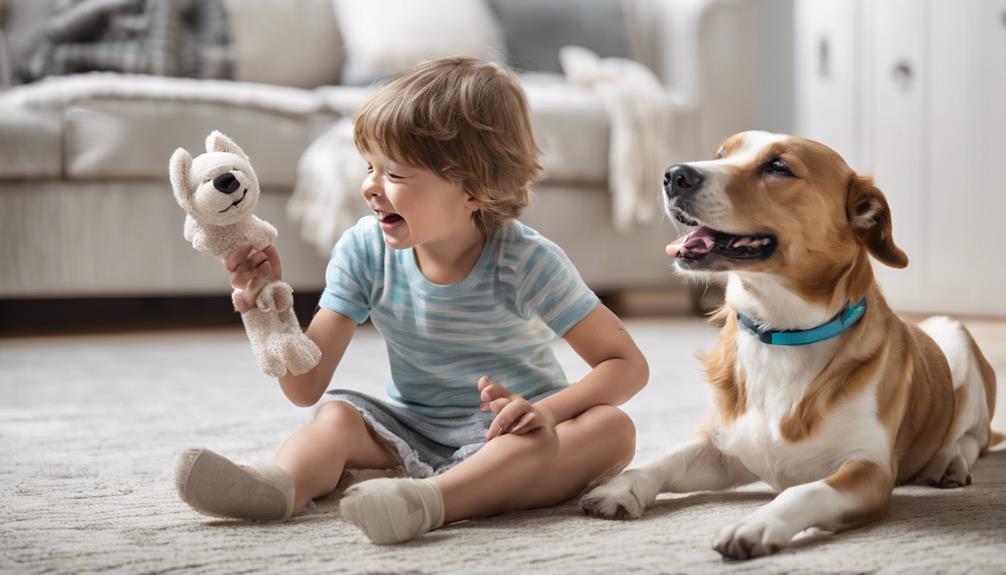
Exposure to dog dust has been proven to lower the likelihood of developing allergies and asthma in kids. Having a dog around can change the gut bacteria, which in turn boosts the immune system.
Dogs can help strengthen immunity in young ones, potentially decreasing the risk of allergies and asthma.
Pet Dander Control
Pets play an important role in maintaining a healthy environment by controlling pet dander, thereby helping prevent allergies and asthma. Exposure to dog dust can reduce the risk of allergies and asthma in children. Dogs alter intestinal bacteria, leading to improved immune responses and allergy prevention. Having a dog around can help build immunity in infants and children. Dogs provide unique health benefits that aid in preventing allergies and asthma. Cats do not offer the same protective effects against allergies and asthma as dogs do.
| Key Points |
|---|
| Exposure to dog dust can reduce allergies and asthma risk in kids. |
| Dogs alter intestinal bacteria, improving immune responses. |
| Having a dog can boost immunity in infants and children. |
| Dogs offer unique health benefits for allergy and asthma prevention. |
| Cats lack the protective effects against allergies and asthma that dogs provide. |
Respiratory Health Benefits
Dogs' unique respiratory health benefits, particularly in preventing allergies and asthma, make them invaluable companions for individuals seeking improved well-being. Exposure to dog dust can reduce the risk of allergies and asthma in children, thanks to the alterations in intestinal bacteria that lead to a better immune response.
Studies also indicate that having a dog around can help build immunity in infants, demonstrating the positive impact dogs make on respiratory health. Compared to cats, dogs provide distinct advantages in preventing respiratory issues, contributing to a healthier home environment overall. For people concerned about allergies and asthma, having a dog may offer significant benefits in maintaining better respiratory health.
Cleanliness and Housekeeping
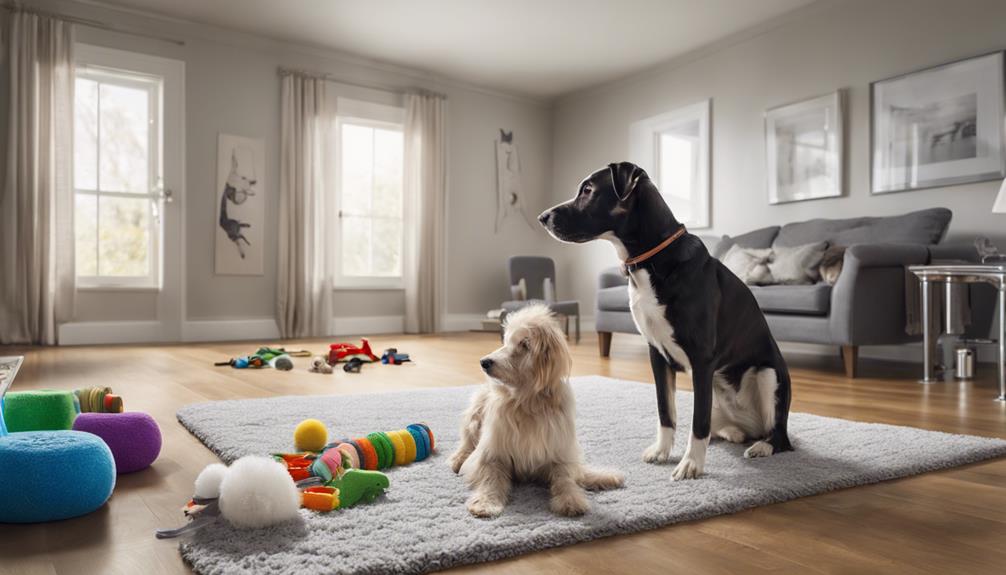
Maintaining a clean and tidy home is easier with dogs, as they can be trained to do their business outside, reducing the need for indoor cleanup. Dogs help you make sure your house stays fresh and clean by learning to go potty outdoors. Dog houses are typically cleaner and neater compared to homes with cats, as dogs keep their bathroom activities outside.
Regular de-shedding of dogs can also help you maintain cleanliness in your house, minimizing fur around the place. Cats and dogs have different bathroom habits, with dogs needing to be taken outside for their business. Dogs can even be trained to let you know when they need to go outside, making the cleanup process more manageable.
Cats, on the other hand, require litter boxes, which can sometimes create odors and messes in the house. Additionally, cats may vomit or cough up hairballs, leading to extra cleaning tasks around the house.
Celebration and Festivities

During festive occasions, dogs bring an extra element of joy and excitement with their enthusiastic participation. Holiday celebrations become even more special when our furry friends join in the fun. Dressing up dogs in costumes for Halloween is a popular activity that many pet owners enjoy. Seeing our pets prance around in themed outfits adds to the festive spirit and creates lasting memories.
Including dogs in holiday activities like parades or family gatherings can make these events even more enjoyable. Pets, especially dogs, have a way of spreading happiness and bringing people together during festive occasions. The experience of dressing up and going out with a dog during holidays can be heartwarming and delightful.
Frequently Asked Questions
What Are 5 Reasons Dogs Are Better Than Cats?
When comparing dogs and cats, five reasons why dogs are superior include their trainability, security instincts, encouragement for physical activity, constant companionship, and unwavering loyalty.
Dogs excel in learning commands, alerting owners of potential threats, motivating owners to exercise, showing excitement when reunited, and staying devoted during tough times.
These qualities make dogs exceptional pets that enhance our lives in numerous ways.
Why Do Dogs Obey Better Than Cats?
Dogs obey better than cats due to their history of working with humans and training. Dogs' ability to follow commands stems from their trainable nature and desire to please their owners. Through training, dogs learn behaviors and cues, enhancing their responsiveness to instructions.
Cats, historically used for hunting, may exhibit less obedience.
The bond between dogs and humans is strengthened by their obedience, making them excellent companions who can work and communicate effectively with us.
What Is Better Dogs or Cats?
When considering whether dogs or cats are better, it ultimately depends on individual preferences and lifestyle. Dogs offer loyalty, companionship, and are great for physical activities like running.
On the other hand, cats are independent and require less maintenance. Both have their unique qualities, so the choice between dogs and cats boils down to personal needs and what one values in a pet.
Choose based on what aligns best with your lifestyle and preferences.
Are Dogs More Loyal Than Cats?
Yes, dogs are generally more loyal than cats. This loyalty is evident in their protective instincts and unwavering dedication to their owners. Dogs prioritize their owner's safety and well-being, forming strong bonds based on trust and companionship.
While cats may exhibit independent behavior, dogs consistently display loyalty and devotion, making them excellent companions for those seeking faithful and devoted animal companions.
Can Antibiotics Affect a Dog’s Behavior and Health, Making Them a Better Pet Than Cats?
Some antibiotics and increased urination in dogs can affect their behavior and health. While it’s important to consult a veterinarian first, antibiotics can improve a dog’s health, making them more active and lively pets than cats. Regular check-ups and proper medication can help ensure a happy and healthy pet.
What Are the Benefits of Feeding Raw Dog Food Compared to Traditional Dog Food?
When it comes to the benefits of raw dog food, many dog owners believe it offers a more natural and nutritious option for their pets. Raw dog food advocates claim it can improve digestion, promote healthier coats and skin, and increase energy levels in dogs compared to traditional dog food.
Conclusion
To sum up, dogs truly are man's best friend. Their loyalty, intelligence, and companionship make them the superior pet choice.
Just like a trusty sidekick in a superhero movie, dogs are always there to support and protect us.
So next time you're considering getting a pet, remember the numerous benefits that come with having a furry four-legged friend by your side.
Choose a dog, and you won't be disappointed!
Dana is our Lead Content Writer, bringing a wealth of knowledge and expertise to our team. With a background deeply rooted in animal studies and a profound love for all creatures, Dana is dedicated to crafting engaging and informative content that resonates with our audience. With Dana at the helm, you can trust that our content is accurate and engaging, catering to the diverse interests of animal enthusiasts everywhere.
Dogs
Top 3 Benefits of Instinct Raw Dog Food: Reviewed
Nourish your dog's primal instincts with Instinct Raw Dog Food, offering essential nutrients, digestive support, and premium quality ingredients that set it apart from the rest.

Instinct Raw Dog Food gives three key benefits: Firstly, by mimicking a wild diet, it connects with a dog’s primal instincts using unprocessed ingredients sourced globally, highlighting their carnivorous roots and essential nutrient intake. Secondly, its high-quality standards feature non-GMO, grain-free elements packed with probiotics and Omega-Fatty Acids, supporting digestive health and overall well-being. Lastly, the nutrient-rich formula contains elevated protein and fat levels from premium animal proteins like liver and kidney, perfect for dogs of any age and promoting a healthy lifestyle. Explore how Instinct Raw Dog Food elevates your pet’s nutrition game.
Key Takeaways
- Supports a dog's natural instincts with raw, unprocessed ingredients.
- Provides high-quality, globally sourced, and non-GMO ingredients.
- Ensures a nutrient-dense diet with 42% protein and 27% fat content.
- Includes essential nutrients like beef liver, kidney, and spleen.
- Promotes overall well-being and is suitable for dogs at any life stage.
Wild Diet Mimicry
Mimicking a wild diet, Instinct Raw Dog Food incorporates real, whole, and uncooked ingredients to satisfy a dog's natural carnivorous instincts for the best nutrition. This approach acknowledges the evolutionary history of dogs as hunters and meat-eaters, emphasizing the importance of raw, unprocessed elements in their diet. By mirroring the diet that canines would consume in the wild, Instinct Raw Dog Food guarantees that essential nutrients and proteins are provided, supporting the overall health and well-being of our furry companions.
Understanding a dog's carnivorous tendencies is important in selecting the right food for them. Instinct Raw Dog Food's commitment to real ingredients that are uncooked aligns with the dietary requirements that have been ingrained in dogs over generations. This wild diet mimicry isn't just a key aspect of promoting a healthy lifestyle for our pets; it's an essential part. With Instinct Raw Dog Food, we can nurture our dogs with the nutrition they instinctively crave, fostering their overall health and vitality.
Quality Natural Ingredients

Utilizing a variety of high-quality meats and nutrient-rich additions, Instinct Raw dog food guarantees superior quality through its selection of natural ingredients. The recipes are carefully crafted to include real, whole ingredients such as beef, chicken, and lamb, sourced globally from trusted suppliers.
Here's why Instinct Raw dog food stands out regarding ingredient quality:
- Non-GMO Ingredients: By utilizing non-genetically modified organisms, Instinct Raw ensures that your furry friend receives a natural and wholesome diet free from artificial interference.
- Probiotics and Omega-Fatty Acids: These beneficial additions support digestion and overall well-being, promoting a healthy gut and a shiny coat.
- Grain-Free and Free from Artificial Colors and Preservatives: Instinct Raw dog food prioritizes natural ingredients by excluding grains, artificial colors, and preservatives, providing dogs with a clean and nutritious meal that aligns with their natural dietary needs.
With a focus on quality, natural ingredients, Instinct Raw dog food delivers a balanced diet that caters to your pet's health and happiness.
Nutrient-Dense Support
Instinct Raw dog food guarantees a nutrient-dense formula with a protein content of 42% and fat content of 27%. This high-quality dog food is packed with essential nutrients derived from top-tier animal proteins like beef, chicken, and lamb. These ingredients, including beef liver, kidney, and spleen, contribute to the best nutrition necessary for your pet's well-being.
With above-average nutrition levels, Instinct Raw dog food guarantees a balanced diet suitable for dogs at any life stage, promoting a healthy lifestyle. The nutrient breakdown in this food not only supports your dog's overall health but also promotes a thriving existence.
Frequently Asked Questions
Is Instinct Raw Brand Dog Food Good for Dogs?
Yes, instinct raw brand dog food is outstanding for dogs. It offers high-quality ingredients, grain-free options, and a variety of formulas for all life stages. Backed by over 20 years of experience, it guarantees excellent nutrition.
What Is the Number One Healthiest Dog Food?
The number one healthiest dog food is Instinct Raw Frozen Dog Food. It boasts a 5-star rating, features high-quality ingredients, and offers above-average nutrition. Would you choose anything less for your beloved pet's well-being?
Is Instinct Dog Food Vet Approved?
Instinct dog food isn't vet-approved, but it's formulated by PhD nutritionists following AAFCO guidelines. Some vets recommend raw diets based on pet needs. Consult a vet before switching. They guide based on health conditions and dietary needs.
What Is the Most Nutritious Raw Food for Dogs?
For my furry friend, the most nutritious raw food is Instinct Raw Frozen Dog Food. Real ingredients like beef, liver, and veggies provide a balanced diet. It's grain-free, GMO-free, and full of probiotics for peak health.
What Are the Specific Benefits of Instinct Raw Dog Food Compared to Other Options?
Instinct Raw Dog Food offers unique health benefits of raw mix. This option provides dogs with a diet closer to what they would eat in the wild, leading to improved digestion, healthier skin and coat, and increased energy levels. Compared to other options, the raw mix in Instinct Raw Dog Food promotes overall well-being for your pet.
Is Almond Introduction Safe for Dogs Who Eat Instinct Raw Dog Food?
Before introducing almonds to dogs who eat Instinct raw dog food, it’s crucial to understand that not all nuts are safe for dogs. While almonds are not toxic, they can be a choking hazard and high in fat. It’s best to consult a vet for guidance on how to safely introduce dogs to almonds.
Conclusion
To sum up, feeding your dog Instinct raw dog food is like giving them a taste of the wild in every bite.
With quality natural ingredients and nutrient-dense support, your furry friend will thrive like never before.
Make the switch today and watch as their energy, coat, and overall health skyrocket to new levels.
Give them the best with Instinct raw dog food – they deserve it!
As our Editor-in-Chief, James plays a pivotal role in ensuring the quality and integrity of our content. With a keen eye for detail and a passion for storytelling, James oversees the editorial process here at A Place for Animals. With years of experience in content editing, James ensures that every piece of content meets our high standards of accuracy and clarity. Under James’ guidance, you can rest assured that the content you read is informative and impeccably crafted.
Dogs
7 Good Names for Your Black and White Dog
Kickstart your search for the perfect name for your black and white dog with these 7 charming options that will add personality and flair – keep reading to discover the ideal fit!
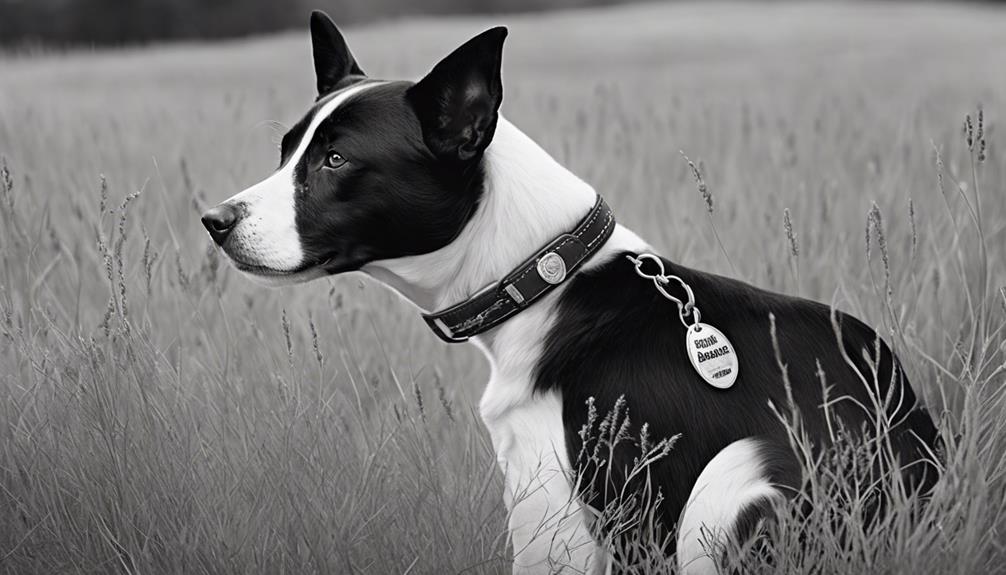
Consider Dottie, Perdita, Domino, Mickey, and others for your black and white dog’s name. These names infuse charm and character into your pet’s persona. Dottie, Domino, and Snoopy bring a fun vibe. Perdita and Mickey have ties to famous dog characters. Choose names that stand out and remain relevant as your dog grows. These options are just the beginning of a list that explores various themes and inspirations for naming your unique companion.
Key Takeaways
- Classic Black and White Dog Names: Timeless options like Dottie and Snoopy for enduring charm.
- Unique Monochrome Dog Names: Personalized names to match your dog's distinct appearance.
- Food-Inspired Names: Culinary titles such as Sushi or Macaron for a playful twist.
- Pop Culture Dog Name Ideas: Draw inspiration from movies or TV shows for a fun and distinctive name.
- Nature-Inspired Black and White Dog Names: Connect with the outdoors using names like River or Luna.
Classic Black and White Dog Names
When selecting a name for your black and white dog, consider classic options like Dottie, Perdita, Domino, Mickey, and Snoopy. These names have stood the test of time and are popular choices for dogs with white fur.
Perdita and Mickey, for example, have ties to famous black and white dog characters in movies, adding a touch of nostalgia to your pet's identity. Dottie, Domino, and Snoopy, on the other hand, bring a fun and playful vibe to the table, perfect for a lively companion.
Choosing a classic black and white dog name can infuse your pet's persona with charm and character. These names not only sound endearing but also have a timeless quality that will stay relevant as your dog grows.
Whether you opt for a more traditional name like Dottie or a whimsical choice like Snoopy, these classic options are sure to make your black and white dog stand out in any crowd.
Unique Monochrome Dog Names

Exploring unique monochrome dog names allows for personalization and creativity in naming your black and white companion. When choosing a unique monochrome name for your pet, consider names that reflect their distinct appearance and capture their individuality. These names can add a touch of charm and personality to your black and white dog, setting them apart from the more common dog names out there.
To find the perfect unique monochrome name, think about your dog's personality and characteristics. Are they playful and energetic, or calm and cuddly? Tailoring the name to match these traits can create a special bond between you and your furry friend. Whether you draw inspiration from food, pop culture, or nature, the key is to select a name that resonates with both you and your beloved pet. Embrace the opportunity to showcase your dog's uniqueness with a name that's as special as they are.
Food-Inspired Names for Bicolor Dogs
When considering food-inspired names for your black-and-white dog, you have a plethora of tasty options to choose from. Culinary canine titles like Sushi, Chocolate Chip, Almond Joy, Macaron, or Swirl can add a delightful touch to your pet's identity.
These delicious monikers not only reflect your love for food but also bring a whimsical charm to your furry friend's character.
Tasty Dog Name Ideas
We enjoy coming up with tasty food-inspired names for black-and-white dogs as a creative and fun way to personalize their identity. When considering names like Mocha, Oreo, or Pepper, you can capture your border collie or Boston Terrier's playful demeanor.
These culinary-inspired names, like Cinnamon or Cookie, can reflect your pet's love for food and add a touch of whimsy to their character. Choosing a food-inspired name for your pet can be a delightful way to showcase your creativity and celebrate your pup's unique traits.
Whether your dog enjoys treats like Sushi or is as sweet as Almond Joy, these names offer a fun and personalized option for naming your beloved black-and-white companion.
Culinary Canine Titles
Let's explore some delightful options for naming your black-and-white furry friend with our assortment of Culinary Canine Titles. When it comes to food-inspired names, pet parents love to draw inspiration from their favorite treats and dishes. These culinary canine titles create a playful connection between you and your dog, reflecting your love for food in a fun and unique way. Consider names like Sushi, Chocolate Chip, Almond Joy, Macaron, and Swirl to add a delicious twist to your dog's identity. These names not only showcase your pet's playful personality but also highlight their love for treats. Culinary Canine Titles offer a wide range of options to match your dog's individual characteristics and charm.
| Food-Inspired Names | Description |
|---|---|
| Sushi | For a sophisticated pup with a refined palate |
| Chocolate Chip | Perfect for a sweet and playful dog |
| Almond Joy | Ideal for a dog that brings joy into your life |
| Macaron | Suited for a stylish and elegant furry companion |
| Swirl | Great for a dog with a fun and whimsical nature |
Delicious Pet Monikers
Occasionally, incorporating food-inspired names can add a playful and delightful touch to your black-and-white dog's identity. For pet lovers who enjoy culinary creativity, names like Sushi, Chocolate Chip, Almond Joy, Macaron, and Swirl can be perfect choices.
These names not only reflect your passion for food but also highlight your dog's unique coloring in a fun way. Choosing a food-inspired name for your black-and-white furry companion can spark conversations and make a lasting impression.
Food-related names bring a charming and humorous element to your pet's persona, showcasing their playful nature and your love for all things delicious. So, consider these delicious pet monikers to give your bicolor dog a name that's as sweet as they are.
Pop Culture Dog Name Ideas

Drawing inspiration from beloved characters in movies, TV shows, video games, and more, black and white dog names rooted in pop culture bring a playful and distinctive flair to your furry companion's identity. Whether you're a fan of Disney classics or Pokémon adventures, there's a vast array of characters to choose from.
Names like Mickey, Minnie, and Goofy from Disney, or Pokémons like Absol and Pancham, can serve as excellent sources of inspiration. When selecting a name, consider characters from your favorite movies, cartoons, or games that have black and white elements incorporated into their design or storyline.
Disney-Themed Names for Your Dog

Exploring Disney-themed names for your black and white dog can infuse a touch of magic and nostalgia into your furry companion's identity. Disney characters like Mickey, Minnie, Goofy, Cruella, and Perdita offer unique and recognizable options for naming your pet.
These names not only reflect your love for Disney movies and characters but also create a fun and whimsical connection with your dog. Choosing a Disney-themed name for your black and white dog is a playful way to showcase your favorite animated films and shows.
The iconic and beloved nature of Disney characters makes their names a popular choice among pet owners seeking charm and character in their dog's name. Whether you fancy the classic charm of Mickey and Minnie or the playful mischief of Goofy, a Disney-themed name can add a touch of enchantment to your black and white furry friend's persona.
Nature-Inspired Black and White Dog Names

Nature-inspired black and white dog names offer a beautiful way to connect your pet with the natural world and express your love for the outdoors. These names draw inspiration from the beauty of landscapes, animals, and elements found in nature, creating a unique and meaningful identity for your furry companion.
Imagine calling out names like Willow, River, Storm, Luna, or Aspen to summon your loyal black and white friend. The choice of a nature-inspired name not only reflects your appreciation for the environment but also adds a special touch to your dog's persona.
As pet parents, selecting a nature-inspired black and white dog name can be a heartfelt decision that resonates with your love for the great outdoors. Each name carries its own significance, embodying the essence of the natural world that surrounds us.
Cool and Trendy Bicolor Dog Names

When looking for cool and trendy names for your black and white dog, consider popular choices like Dottie, Perdita, and Domino that reflect modern pet naming trends. Here are some ideas to help you find the perfect name for your stylish pup:
- Mickey: A fun and iconic name that adds a touch of personality to your black and white dog's identity.
- Snoopy: A cool and classic choice that pays homage to a beloved pop culture character.
- Speckles: Reflecting your dog's appearance, this name can be a meaningful and unique option.
- Oreo: A themed name that combines the colors of your pet in a playful and memorable way.
Exploring these cool black and white dog names can be an exciting journey for pet lovers seeking a trendy and unique moniker for their furry friend. Whether you're drawn to modern trends or classic references, there's a perfect name out there waiting for your bicolor pup.
Frequently Asked Questions
What Should I Name My Dog in Black and White?
We've got some cool ideas for naming your black-and-white pup! Consider names like Oreo, Panda, or Checkers. Reflect their colors with names like Pepper, Smudge, or Tux. Make sure the name suits their looks and personality!
What Are the Black and White Dogs Called?
Oh, the joy of owning a black and white dog! They're often called 'piebald,' 'harlequin,' or even 'panda dogs' for their unique coat. Some refer to them as 'parti-colored' or simply 'spotted.' How delightful!
What Would You Name a Black and White Animal?
If we were to name a black and white animal, we might consider monikers like Oreo, Panda, or Patches. These names capture their unique colors and playfulness. Ultimately, the right name should resonate with your heart and bond with your companion.
What Is the Name for a Black and White Object?
When we think of a black and white object, we envision the timeless elegance and stark contrast it brings. This classic combination symbolizes sophistication and simplicity, making it a powerful choice in design and art.
Can I Use Blue-themed Names from the Ultimate Guide for my Black and White Dog?
Yes, you can definitely use blue-themed names from the ultimate guide blue dog names for your black and white dog. Names like Midnight, Slate, or Navy can be a perfect fit for your pet. Get creative and choose a name that suits your dog’s personality and appearance.
Are French Dog Names Suitable for a Black and White Dog?
Looking for the perfect name for your black and white dog? Consider choosing from a list of beloved French dog names. Classic names like Pierre, Chanel, or Oreo can be a unique and fitting choice for your new furry friend. French dog names can add a touch of elegance to your pet’s identity.
Conclusion
To wrap up, picking a name for your black and white dog can be an enjoyable and imaginative process. Whether you choose a traditional monochrome name, an original option, a food-related selection, or a pop culture allusion, there are numerous possibilities to explore.
Keep in mind to select a name that mirrors your dog's character and complements their appearance. So, what name will you select to perfectly capture your furry friend's essence?
As our Editor-in-Chief, James plays a pivotal role in ensuring the quality and integrity of our content. With a keen eye for detail and a passion for storytelling, James oversees the editorial process here at A Place for Animals. With years of experience in content editing, James ensures that every piece of content meets our high standards of accuracy and clarity. Under James’ guidance, you can rest assured that the content you read is informative and impeccably crafted.
-

 Vetted1 month ago
Vetted1 month ago15 Best Dog Food Brands Recommended by Vets for Healthy and Happy Pups
-

 Vetted1 month ago
Vetted1 month ago14 Best Homemade Dog Food Recipes Your Pup Will Love – Vet Approved & Nutritious
-

 Vetted1 month ago
Vetted1 month ago15 Best Cat Foods for Managing Hyperthyroidism – Vet Approved and Feline Friendly
-

 Vetted3 weeks ago
Vetted3 weeks ago15 Best Dog Foods for Kidney Disease – Expert Recommendations for Your Pet's Health
-

 Vetted2 weeks ago
Vetted2 weeks ago15 Best Affordable Cat Foods That Won't Break the Bank
-

 Deers1 month ago
Deers1 month agoCaring for Baby Deer: Tips for Healthy Fawns
-

 Cats6 days ago
Cats6 days agoCat Weight Chart by Age: Kitten to Senior in Lbs
-

 Vetted1 month ago
Vetted1 month ago15 Best Kibble Dog Foods for a Healthy and Happy Pup




















